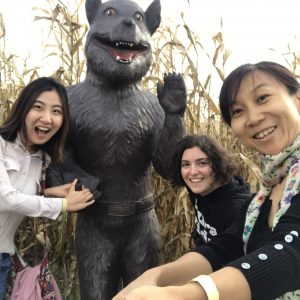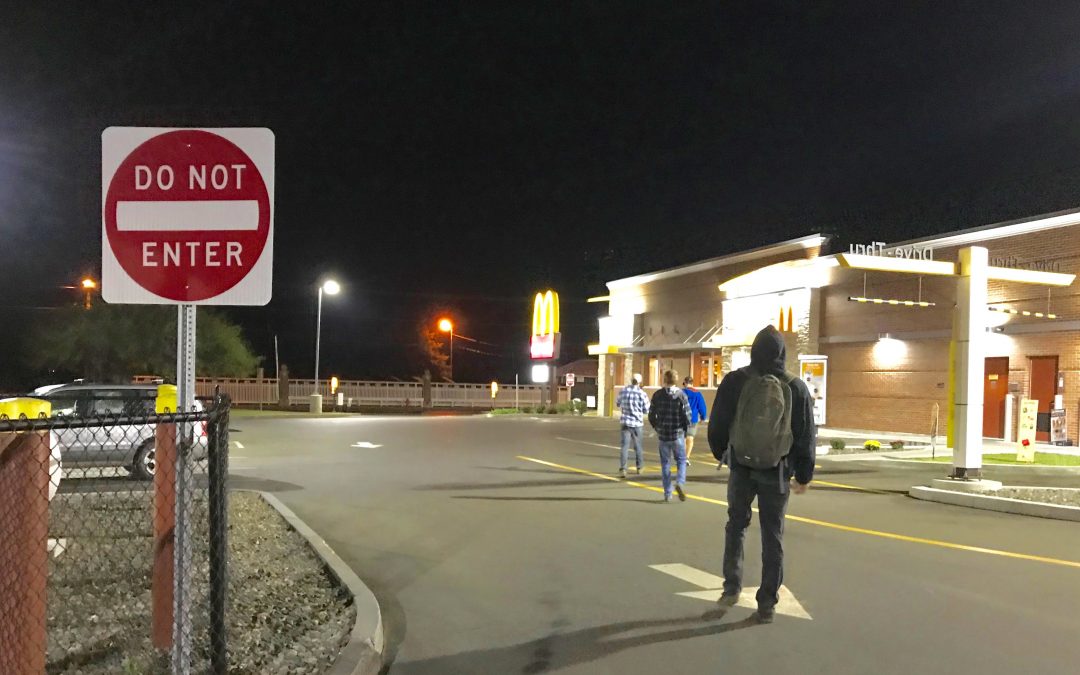
Oct 27, 2017 | Feature |
By Cheyenne Judkins – Contributing Writer
As tattoos are on the rise on the UMF campus, many students are getting them for very special reasons. These art pieces come in many shapes and sizes, but they’re all significant, some even have a story. Some people get tattoos for family members, lost loved ones, or more personal reasons, but each one is unique. Here are some around UMF…

Rachael Chavarie, junior Elementary Education Major.
(Photo courtesy of Rachael Chavarie)
Rachael Chavarie, a junior and Elementary Education major at UMF has a faith over fear tattoo that is near and dear to her heart. “I got this tattoo based off my favorite bible verse, ‘When times I am afraid, I will trust in thee’ Psalms 56:3” Chavarie said. She described herself as someone who often worries and overthinks things she has no control over, but her faith has always been there for her to lean on. “Throughout my life I’ve also come to realize that God has never let me down once and that he always has my best interest at heart,” Chavarie said, “I decided to get this tattoo as a permanent reminder to always keep my faith above any fear I have no matter how little it may be.”

Mikayla Wyman’s symbol of her grandparent’s love story.
(Photo courtesy of Makayla Wyman)
Mikayla Wyman, a junior Early Childhood Education major has a dove tattoo with French words on the back of her neck to represent her grandparents love story, “Je t’aime means ‘I love you’ in French, and it’s written in my grandmother’s handwriting” Wyman said. This tiny token is a constant reminder for her of how her grandparents fell in love.

Amanda Swart’s tribute to her grandfather.
(Photo Courtesy of Amanda Swart)
Amanda Swart, a junior Outdoor Recreation, and Business Administration major also has a tattoo for one of her grandparents. “I got this tattoo in memory of my grandpa,” Swart said, “the rose stands for ‘Rosie’ which he always used to call me, and the writing is his own from postcards he’d send me once a month for my entire childhood,” Swart says he was the greatest man in her life, and she continues to fall more in love with her tattoo every day.

Areyanna Yslava’s matching Mario tattoo with her fiance.
(Photo courtesy of Areyanna Yslava)
Areyanna Yslava is a junior Elementary Education major, she decided to get a mushroom tattoo from the game Marion with her fiance, “Most people look at my tattoo and see something from a video game,” Yslava said, “but to me its not just a silly cartoon, the mushroom is an extra life, a second chance at being happy and having a fulfilling life, which is what he [her fiance] gave me.”

Christina Taylor’s compilation of all her artistic interests.
(Photo courtesy of Christina Taylor)
Christina Taylor, a junior Business Psychology major designed her own custom tattoo with her artist, “It encompasses all of my artistic interests,” Taylor said, “costuming, sewing, theater, and music are all incorporated.” She shared the treble clef is backwards so she can see it clearly in a mirror, and she chose the color pink because it’s her favorite color.
Tattoos may seem small and meaningless to someone glancing at it from across the room, but they often have an underlying meaning for the person they belong to. The ink under these peoples skin are not just drawings or art pieces, they’re stories.

Oct 27, 2017 | Feature |
By Leah Boucher -Staff Reporter
The sun shone on a Friday morning through the basement windows of Dakin into the dance studio, where red and dark blue costumes reflected their sparkles onto the walls. Three mirrors placed together on the front wall captured a choreographer in leggings and a comfy green sweatshirt mouthing the count of the music while the floor vibrated with the bass of hip-hop music.
Kayla Tremblay, the dancer in front of these mirrors, can be found here for at least a half an hour each Sunday through Friday dancing in eight different routines for Bust-A-Move Beavers (BAM), the dance club on campus she has been a member of since the first semester of her freshman year.

Kayla Trembley, senior Elementary Education Major at UMF
(Photo courtesy of Kayla Trembley)
Tremblay, a senior Elementary Education major, smiled and leaned back on the wall filled with old dance showcase posters from the 90’s as she thought back to her previous years of dance. “This will be my 19th year of dance, and I started dancing at Steppin’ Out Dance Centre in Saco, Maine, at the age of three,” said Tremblay. “It has always been a way for me to let my stress from work and school out.”
Her motivation to continue dance past high school even led her to participate in a clogging competition with Danica Lamontagne, another BAM member, this past spring, where they placed first. “This was the first competition that I signed up to do without being part of a competition team,” said Tremblay, “and being able to make the choice by myself was a big step of independence and confidence for me.”
This stress relief activity is helpful now more than ever, as Tremblay has been a member of BAM, Rotaract, the Rugby Team, French Club and chair of the Spring Fling committee, as well as Alpha Lambda Delta, in which she holds the position of President. She also just finished mailing out cards for “Brocktober” at UMF, where people write and decorate Halloween cards for a terminally ill boy named Brock in Biddeford. Her natural leadership abilities led her to organize this event all on her own while encouraging the clubs she is a part of to contribute, as well.
“When I first heard about Brock, I knew I wanted to get involved,” said Tremblay. “I knew if I reached out to other UMF clubs and organizations, they could help to make this event bigger than just myself writing several cards to him.”
Tremblay wiped off her forehead as if to get rid of the sweat from just thinking about her hectic daily schedule. “I work about 15 hours a week in the Partnership for Civic Advancement office, and with a full load of classes, plus all my clubs, sometimes I am forced to eat dinner on the run or do my homework in 15-minute increments,” said Tremblay.
Reflecting back on her four years in BAM, Tremblay’s face became solemn, but she then quickly switched back to her usual radiant grin. “It’s bittersweet knowing that I’m leaving such a supportive group when I graduate this May,” she said. “Everyone is willing to block out everything else that they may have going on to be an active part of rehearsal, but if someone does need support, there’s 41 other people to listen and help–it’s the perfect family network to be a part of.”

Oct 27, 2017 | Opinion |
By Haiyu Zheng -Contributing Writer
When the view of ten acres of cornfield finally came into sight as we drove, my friends and I started feeling thrilled about heading out to the field with excitement and an adrenaline rush.
I was a little bit overwhelmed when standing in front of the massive landscape with piles of brown plants filled with ripening ears of corn. Looking up at these huge rippling stalks, I thought to myself, “Oh my gosh, they are wicked tall.” This was my first experience of seeing a corn maze in person. It reminded me of the crop circle that I saw in a documentary when I was in China, before I came to UMF.
That Sunday afternoon, instead of dying while doing my homework, I decided to have an adventure at the corn maze at the Sandy River Farm on Farmington Falls Road with UMF senior Elina Shapiro, and Chinese instructor Hui Shao.

From L to R: Haiyu Zheng, Elina E. Shapiro, and Hui Shao at the Sandy River Corn Maze.
(Photo by Hui Shao)
Sandy River Farm is a vast fascinating landscape that consists of 600 acres of land in pastures, hayland, and rows of crops as well as approximately 1000 acres of forest land. The corn maze named “Amazing Maize” is held on the field south of the farm. In addition to the maze, the farm also offers a pumpkin patch and a “Cow Train” ride for kids.
The first thing we noticed was the tower near the entrance of the maze. Visitors could go upstairs on a staircase ascending to the top of a tower to perceive the entire farm.
Shapiro commented that “the view was as far as you could see and pretty much any direction you looked there was corn.” Surprised, she raised her voice and said, “even behind me I saw corn.”
After that, we finally started our journey.
I honestly didn’t know what I expected in the beginning, so I think I made a lot of stupid suggestions.
“I’ve heard a theory that you can go out very quickly if you chose the same direction every time you have to make a choice,” I said. “Like you just stay to the right side.” I was as confident as a professional.
After the first few minutes, we found that we were back to the same spot we started from, which meant we didn’t go anywhere.
This time I changed the strategy. I picked some corn up off the ground and made signs with them. I thought I was pretty smart.
A few minutes later, I heard Shao’s voice. “Oh, no! I think we’ve been here before!” Yes, we got lost in the circular trails created by these tall plants.
“What if we cannot find the way out?” Shao asked. Well, this was a good question.
One of the things that I was hyper-aware of was how confusing it was. After failing so many times, I realized that I was probably not a “puzzle” person so I totally gave up and let my friends lead me to whichever direction they thought fit.
We came across several families with distinctive, interesting approaches. Many families enjoyed getting lost in the maze. One family said quite casually, “we were just wandering.” Another used their Google map to direct their way, and one just enjoyed playing with their kids while they were walking.
Shapiro suggested taking on the philosophy of wandering instead of being nervous about figuring out which way to go. We all thought that was a good idea, so we ended up following the family using the Google map. (Technology is good.)
I remember how excited we were when making a significant breakthrough of going through the intermediate part of the maze. As the maze went on, we passed through the paths more easily when we found that there were signs of numbers placing strategically throughout the maze. In another twenty minutes, we found the exit!
I couldn’t believe we made it! We celebrated our victory by taking a lot of selfies with a werewolf statue at the exit, which was also near the entrance.
Before leaving, we had a short tour exploring the other parts of the farm. Walking through a sea of pumpkins of all kinds of shapes, we got on a truck that took us to a place with some animals. I approached a goat and pet his fuzzy head. Embraced by the unexpected natural grace, I forgot all the clutter and clatter of life in this bright, breezy Sunday afternoon. It was an awesome trip.
There will be a haunted maze going at the end of October. It freaks me out when thinking about encountering creepy clowns or vampires who suddenly pop out of a corner. But for students who have a resilient heart, more information can be found on the Sandy River Farm’s Facebook page.
Oct 16, 2017 | News |
By Anthony Lewis – Contributing Writer
The onset of the fall semester brought the New Commons Project, a public humanities initiative spearheaded by Interim Provost Eric Brown and Associate Professor Kristen Case, and generously funded by the Mellon Foundation.
“For the New Commons Project, we wanted to ask students, faculty, high school students and community members to propose works of culture that we need now,” said Case.
Open to anyone in Maine, the New Commons Project aims to create a canon of 24 works of culture, which can include “novels, paintings, plays, albums, films, performances [and] works of philosophy.”
A project by and for the community, one of the key concepts of the New Commons is the nomination of works that can be applied to modern society in a constructive and meaningful way.
“What are our cultural resources for the moment that we’re living in? What are the things we really need to turn to in this particular moment?” Case asked when describing the questions the New Commons Project tries to answer. “Maybe we need a work to teach us about something, or maybe we need that work because it brings people together, or maybe we need that work because we’re all really stressed out and need something that will make us laugh.”
The project came as a result of an invitation from the Mellon Foundation–a multibillion-dollar endowment that writes grants primarily to private institutions–to have UMF submit a proposal for a highly coveted grant.
Professor Brown, who was tasked with the daunting responsibility of drawing up the proposal, met with a representative from the Mellon Foundation in the fall of 2016.
“Mellon was looking specifically at COPLAC schools,” Brown said. “UMF is part of this Council Of Public Liberal Arts Colleges. President Foster and I had an initial talk wondering if we should go for it. We had to get a preliminary paper to them by mid-January, and this was in mid-December.” Professor Brown smiled and raised his eyebrows, as if to wonder to himself how he ever pulled this off. “We thought that, even though it was going to be a crunch, in the end it was worth doing.”
“The idea of a commons is to have one resource we all have access to and that we all have to care for,” said Case. “The whole idea behind the grant is that we want to think about culture as a commons. We’re looking for something that is not housed at the university. It belongs to everybody.”
The idea that the New Commons Project is rooted in community was echoed by English professor Dan Gunn.
“I think the idea here is to combat the notion that there’s a strict canon controlled by academics, and the value of the humanities as only to do works out of that canon,” said Gunn. “The idea is to think of the humanities as a resource for everyone in the community, and to think of that canon as shifting.”
Music professor Steven Pane expressed a similar sentiment about the project.
“The big misunderstanding in our culture is that somehow, whether it’s Bob Dylan or The Iliad, that these things are what you do in school,” said Pane. “But really it’s what you do in life. Rather than associating this with college, it should be all of ours to share.”
“A lot of times, when people hear about this project, they think ‘oh, this is something for some other kind of person’,” said Professor Case. “Something that is for some person who knows more about culture than I do, or who’s an English major, which is insane. The whole project is designed to counteract the idea that culture is something you have to have special expertise about. Every single person in the world knows about culture.”
Professor Case gets more and more excited as she speaks; her voice rises, her hands gesticulate and a smile flashes across her face. “You live in a culture. You consume it every day. This is really just trying to convince people that the culture they know and care about is what we’re interested in.”
The first round of selections will be made in March of 2018 by a committee including Professor Case, Professor Brown, students and members of the community. The deadline for submissions is March 15, 2018.
Submissions, in the form of 3-4 minute videos, can be uploaded at www.maine.submittable.com/submit.

Oct 13, 2017 | Exclusive |
Lindsay Mower – Staff Reporter
In effort to increase health promotion, some towns have adopted drive-thru bans for fast food establishments. In some communities this type of ban has been around as far back as 1982: like San Luis Obispo, a college town located on the central coast of California.
With a population of 47,526, as compared to Farmington’s population of 7,760, San Luis Obispo is characterized by small shops, happy pedestrians and open sidewalks. The community originally adopted the ban in effort to maintain air quality, preserve the town’s character, promote a more pedestrian-oriented community and to reduce the high volume of traffic. A year later, neighboring City of Pismo Beach also banned drive-thrus within their Coastal Zone, followed by Arroyo Grande in 1991 and the City of Paso Robles in 2004.
“A student group galvanized citizens to push through a project that created a cultural and social focus for this city and, in doing so, improved the quality of its government. With more citizen participation, the town’s focus shifted away from optimizing the business environment to maximizing quality of life,” says an excerpt from ‘Thrive: Finding Happiness The Blue Zones Way’ by Dan Buettner, ‘In Lessons From San Luis Obispo’ published on BlueZones.com.
San Luis Obispo can’t keep a McDonald’s establishment in business. How can a college town in California with nearly five times the population of our own college town in Maine be unable to support a single McDonald’s, albeit one lacking a drive-thru, while we successfully support a Burger King, Taco-Bell, KFC and Dunkin Donuts, in addition to a McDonalds, and have various local restaurants in town that offer delivery and take-out options? While San Luis Obispo is a pedestrian-oriented community, Farmington’s drive-thru district is not. The bulk of our drive-thrus are located only in driving distance, making them a common option for busy people passing through who are most likely short on time to prepare a meal for themselves.
With Franklin County being one of the more unhealthy counties in Maine, at first glance it would seem like an obvious solution for Farmington to adopt a ban like this in effort to promote healthy lifestyles among the population.
Community Health Professor Maurice Martin admits he has never considered the implications of a removing the drive-thrus at fast food establishment in the name of health promotion. “I think if Farmington were to adopt the ban there would certainly be a boom to the area small businesses, which when the area small businesses are doing well, the general community health improves: on all levels, not just physical. If this were the case, that would be a huge benefit,” said Martin. “As far as whether or not people would curb their eating of fast foods, yeah, I think so… I can say for myself, if I want fast food it’s the drive-thru. I never go inside, because the idea of fast food is, ‘I’m hungry, right now.’”
Drive-thru ordinances may be inconvenient, especially to communities like Farmington, although their effect on overall population health has quite the silver lining. According to Buettner, as a result of the of the ordinance in San Luis Obispo they “gained a more aesthetically pleasing downtown, with less traffic, less pollution, more gathering places, projected green spaces, a farmer’s market, thriving arts, and an environment where it’s harder to do things that are bad for you (smoke, eat fast food) and easier to do things that are good for you (walk, eat vegetables, recreate in nature, and bike). The result is arguably the healthiest and happiest city in America.” San Luis Obispo has also adopted an Anti-smoking Policy.
Anthony Lewis, UMF English Major with a concentration in Music and Writing, doesn’t see drive-thru bans turning out as successfully in Farmington.“I don’t know if it would solve the problem here, it might help to alleviate the issue at hand, but I don’t even think it will happen,” says Lewis. “The government moves very slowly, everybody loves a good drive-thru and companies like McDonald’s make tons of money on them, so they will never want to give them up.”
The manager at the Farmington McDonald’s establishment was contacted but declined to be interviewed by the Farmington Flyer.
Martin suggests that, for health purposes, it may be a good idea for Farmington to put into effect a moratorium on drive-thrus, meaning no more can be added to the community than what already exist. “I don’t think that you are going to see the fast food establishments agree to a ban, nor do I think that the general population would agree that they should eliminate drive-thrus. Even though I would agree, they are here, and to roll back the clock is difficult.”







